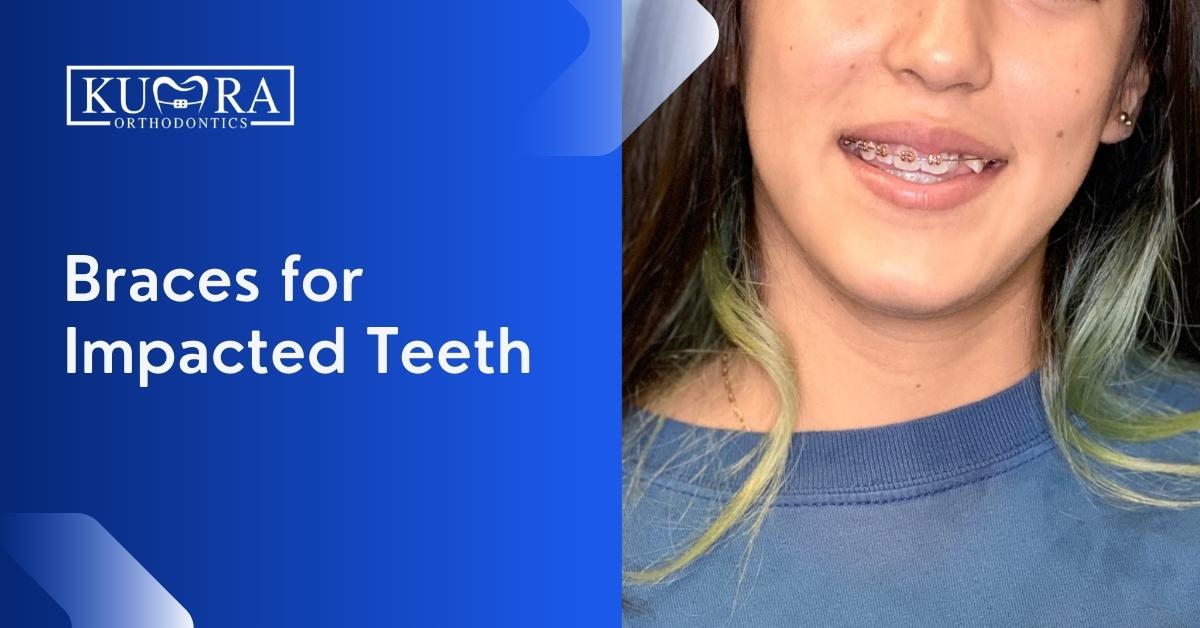An impacted tooth has not gone through the gum line and is, therefore, unable to grow into its proper place on its own. Rather than that, the tooth becomes embedded – or impacted – in the gum tissue or bone. If left untreated, this might result in dental difficulties and other health problems.
There are multiple possible reasons for impacted teeth and numerous treatment options, such as impacted canine tooth braces.
What are Impacted Teeth?
When teeth are unable to come in properly on their own, such as when the baby teeth fail to fall out or when there is not enough room for all of the teeth to come in, the result is impacted teeth. This is a situation where the teeth are either barely visible above the gum line or are entirely covered beneath the gums.
Some people may have several impacted teeth, while others may only have one. It’s all a matter of genetics. To some extent, this is influenced by the origin and pattern of the eruption of impacted teeth. Some people are born with impacted or decayed baby teeth but have healthy adult teeth. Depending on your teeth, this may or may not work for you.
It’s crucial to keep an eye on impacted teeth, even if they aren’t causing you any discomfort or agony. You may be completely ignorant that they are there. This may necessitate moving it or taking it out entirely in certain cases.
Types of Impaction
Horizontal impaction
The most painful type of impaction is horizontal impaction, which occurs when the tooth or teeth grow sideways, completely beneath the gums. As the name implies, the tooth will shift and grow horizontally, pressing forward on the molar in front of it. This type of impaction is identified via x-ray and, if left untreated, will certainly cause damage to neighboring teeth and terrible discomfort. This extraction should be performed while sedated intravenously or under general anesthesia.
Vertical impaction
Vertical Impaction occurs when the tooth grows and erupts vertically but is too close to the adjacent molar, pressing against or forcing it beneath. This form of impaction is very likely to erupt naturally, and most cases do not require surgery to remove.
Angular impaction
There are two distinct types of angular impaction that might take place. It is called distal impaction when a tooth leans toward the back of the mouth and is unable to erupt. The dentist or surgeon has the full decision on whether or not to remove this rare form of tooth impaction. The angle of the tooth and whether or not it will grow large enough to impact the jaw bone are the primary factors in this decision.
Partial impaction
The most common type of tooth impact is a mesial impact, which is the polar opposite of a distal impact in that the tooth is inclined forward toward the front of the mouth. Mesial impaction, in which the rear of the tooth emerges while the front is pressed against the anterior molar, is a common cause of partial eruptions.
Needing an orthodontic appointment?
Visit Kumra Orthodontics Washington, DC or Kumra Orthodontics Stafford, VA, and request an appointment with us!
Causes
Overcrowding in the dental arch is the most common cause of an impacted tooth. Too little room in the jaw might cause teeth to grow unevenly and overlap.
Other causes include:
- Factors genetically predisposed to damage the teeth or jaw
- The tooth has ceased to protrude because it has been twisted or grown at an angle that does not fit.
- The tooth is too large to fit in the space required for growth.
- Accidental tooth damage affects the erupting adult tooth beneath, resulting in the adult tooth becoming impacted.
Braces to Treat Impacted Teeth
Braces are frequently utilized to aid in the treatment of impacted canine teeth. Braces can be used to reposition an impacted tooth. When the tooth is upright and in its proper position, it can now be used for biting and eating.
However, if the affected canine does not erupt into the area provided, the tooth may require an uncovering operation performed by a different dentist (a referral would be required). This technique exposes the impacted teeth, which can then be fitted with braces to facilitate movement into the mouth.
If an impacted tooth has resulted in crowding or crooked teeth, braces can be used to bring numerous teeth into their desired positions, resulting in a straight and properly spaced arch of teeth. Braces are used not just for aesthetic purposes but also to promote oral health by making teeth simpler to clean.
Contact Kumra Orthodontics to learn more about impacted canine tooth braces
Impacted teeth can cause multiple dental problems that can disrupt your day. The good news is that impacted canine tooth braces may correct space and alignment concerns caused by impacted canines.
Please contact Kumra Orthodontics right away if you have any questions. If you’re looking for a perfect smile, we’ll work with you to construct a treatment plan tailored to your unique needs.


